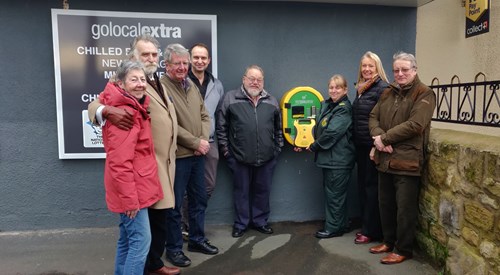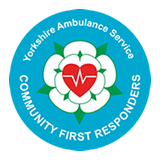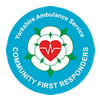Community Public Access Defibrillators (CPADs)
What is a defibrillator?
A defibrillator, sometimes known as an Automated External Defibrillator (AED) is a small electronic device designed to allow minimally trained people to provide lifesaving defibrillation (electric shock to the heart) to victims of sudden cardiac arrest.
The device analyses and looks for shockable heart rhythm, advises the rescuer of the need for defibrillation and delivers a shock if needed.
A defibrillator applies a brief pulse of electrical current allowing the heart’s normal electrical system to resume normal control. (Please note that a 100% success rate cannot be guaranteed, but this could be the casualty’s best and only chance of survival).
What are CPADs?
CPADs are cabinets located on the outside wall of a building so that the AED inside can be accessible 24/7 to anyone in the vicinity who requires it. It means more people could benefit from the presence of your device and more lives could be saved.
The cabinets have a key code lock and the code is accessed by calling 999 which means the device re-mains secure. By having an AED accessible quickly and easily 24 hours a day in your community you are showing how much you care about the safety of the residents and visitors.
How much does it cost?
The cost will vary based upon your requirements. We have worked with various suppliers to be able to offer AEDs and cabinets at a reduced cost. A typical example of the cost to set up a CPAD in your community would be £1400 (including VAT).
Are we entitled to funding for our CPAD?
Yorkshire Ambulance Service (YAS) currently does not fund CPADs but we can work with you to look if there is any specific funding in your area.
How do we order equipment via YAS?
If you would like to go ahead and order a CPAD for your community then please send an email to yas.communityresilienceaed@nhs.net and we can discuss the various options available to you.
Where should we site our CPAD?
In terms of where to site it our guidance would be;
- Somewhere well lit.
- CCTV is great if possible.
- Somewhere where the most people tend to be/gather.
- Somewhere where an external wall faces onto a public path/area and there is an electricity supply to tap into.
- The owners of the building need to agree to its installation and to paying for the electricity supply.
- Usual places are public houses, village halls, post offices, sports pavilions, GP surgeries.
Do we need training to use an AED?
We appreciate that this is often a concern but the current stance in the UK is that you do not need training to use an AED. The Resuscitation Council (UK) along with the British Heart Foundation (BHF) have produced a guide to AEDs which should help with any questions you may have.
Where is the nearest defibrillator to me?
YAS are encouraging local communities to register their defibrillator with The Circuit (see below). You can find the nearest registered defibrillators to you by clicking here.
How do we register our defibrillator?
Are you responsible for a defibrillator? Make sure you register it so that we know where it is in an emergency.
Registration is quick and easy via The Circuit, the national defibrillator network brought to you by the British Heart Foundation in partnership with the Resuscitation Council (UK) and the Association of Ambulance Chief Executives. The Circuit replaces our previous method of logging defibrillators directly on our 999 system.
The Circuit will also help you to look after and maintain your defibrillator. You will receive regular reminders to check that your device is emergency ready and be able to connect with other guardians in your area should you wish for someone to check it when you are away.
It’s quick and easy register, simply ensure you have the following details to hand:
- Defibrillator location and surroundings
- Brand, model and serial number
- Available time of use
- Pad expiry dates
- Assurance that it’s emergency ready
Register now, and help us to start saving more lives today.
If you have any questions or concerns please refer to the ‘Frequently Asked Questions’ that you will find at the bottom of the Register Your Defibrillator page!



